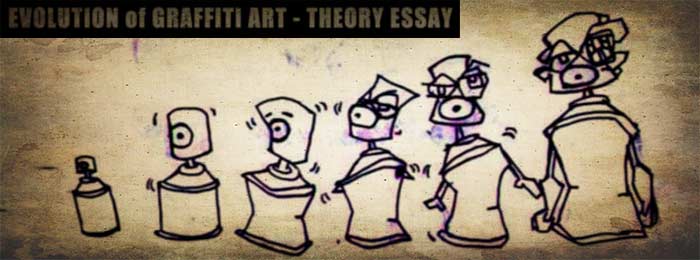ViNNi KiNiKi Art Store
Graffiti, Graff, Street art, Stencils, Stencil art, Wheat pasties, urban art in the year 2013 What is the future? Graffiti art thesis by Vinni Kiniki

Graffiti Art thesis essay about the evolution and future about Street Art by Vinni Kiniki
There is a shift (or evolution?) in graffiti style all over the world it has occurred in Bangkok, Thailand also. Here many taggers and strictly letter and font based artists have switched to painting images and characters (cartoon style) rather than painting text and font. I attribute this shift with the evolution and survival of urban and street artists as graffiti becomes a mainstream art form which is enjoyed by the many rather than an esoteric core elite. I have a few socio-cultural theories revolving around ‘graffiti’ as an art form, but before I say anything allow me to clarify; I am not talking about Webster’s or Collin’s dictionary definition of the word ‘graffiti’ (that which refers to lewd and unruly anarchist writing in public spaces). I am talking about graffiti as the art form that we as the modern culture have defined it; art which adheres to at least one of the following criteria;
- Urban style art created using a spray can
- Created on or for the intent to be displayed in public places (illegally or legally)
- A highly collected and celebrated art form born out mainstream contemporary culture’s love for all things ‘urban’, ‘street’, ‘raw’ and ‘edgy’
- A visual art commonly associated with underground hip-hop culture and fashion.
Mainstream society’s handling and representation of Graffiti has always allowed a few key players to shine above the rest, be celebrated, valued and be perceived as desirable vandals, the remaining graffiti artists are not so lucky they will be treated not as artists but as common criminals, vandals with no talent. Ever heard the one about ‘Banksy’ street art raising the property value of someone’s house once he has marked it? There are thousands of stencil artist equally as good as Banksy but I guarantee you their treatment by the long arm of the law would not be a lenient. The truth is art in general is one of those esoteric things where most uneducated or unknowing people will praise that which they are told is good. Graffiti is no exception to this rule.
What makes a graffiti artist prominent for the given time period?
I’m not a scholar or a historian this is simply my take on the graffiti phenomenon as I’ve encountered it through experience, verbal communication and text I’ve read and researched on the subject.
Fame (notoriety through bombing and presence, to some graffiti artists “being up” is still the number one pursuit in the game of graffiti. Quantity over quality – everyone can have a go and no one is discriminated against, certainly not due to skill level of using a spray can. Noted time period late 70’s.
Style. The term ‘wild style’ which was coined in the 80’s Bronx, New York refers to a style of graffiti which is superbly complex, colourful and detailed (and very hard to mimic – even by the experienced graffiti writer). The creation of the style could have been a survival response to the previous category; ‘fame’. How else to get noted other than being seen everywhere? The one rules the many, ‘i can do this with a spray, what can you do?’ this is the time when graffiti as we know it left the shores of America and people in Europe notably were taking it to next crazy levels keen to catch up and integrate and ultimately make their mark on the global graffiti scene. Quality over quantity.
Message – This one is rather timeless I’d say. Like I said the original graffiti which some refer to going as far back as the Roman or Egyptian times is rogue writing or messages usually anarchist in feeling and often anti popular propaganda. However to bring it into a modern perspective artists such as everyone’s favourite street art poster boy ‘Banksy’ (the irony is that you will never see him in the flesh). For sure you have read his words or deduced your own statement of intent from analysing his work. Message category certainly suited the style of the apathetic 90’s, the people needed to wake up to their own voices. We as a global nation knew something is wrong, apart from the common forum of the internet the street proved as a great posting board where the window could not be closed with the click of an X.
Ingenuity – This to me sums up the graffiti movement in the year 2000 in general. Across the creative and other social board’s people are aiming to bring something new to the table. Combining styles, ideas and contexts. Certainly the graffiti art form was exhausted in terms of using a spray can and a wall. During this time period a street artist doesn’t necessarily get recognition from ability, balls or coverage but more through gimmick and uniqueness. A noted player would be someone like French artist ‘space invader’ who uses mosaic tiles over stencils, spray paint and wheat pasties. His actual artistic talent can be heavily debated but regardless his style and art is celebrated. I could make a brief analogy to the post-modernist movement where players such as Duchamp were celebrated for exhibiting a urinal in an art gallery context and calling it art. No artistic skill is required, anyone could’ve done it…Perhaps that is the beauty of Space invader’s work, people feel it’s something they can do and feel included. Some people can argue that it is in fact Banksy who should be king of ingenuity, personally I’d disagree this on the merit of his stencil work but perhaps some of his other 3D (street sculpture?) work breaks certain boundaries of creation in a ‘street art’ context.
Lastly I announce the most modern measure of the popular and desirable ‘street artist’ (notice it’s not a derogatory term like graffiti or vandal anymore?)
Mass appeal – We live in the world where what sells is king, and quite frankly most graffiti (or art in general) where the artist prides himself on skill and style means fuck all when compared to whether people are buying it or not. So artists are producing for the people. Graffiti is popular as an art form and its style must reflect it thusly. Many graffiti artists have ditched wild style and complex or grotesque concepts in favour of cute, recognisable and cuddly – something that everyone can enjoy. I guess in an ironic way the complex graffiti from previous years was far too esoteric and ‘hi-brow’ (lol) for the common person or even gallery owner to enjoy. Certainly people like Keith Haring and Jean Michel Basquiat went a long way to breaking down these boundaries but it’s still hard to imagine a Brooklyn gangbanger graffiti artist and a flamboyant effeminate gallery owner having tea and crumpets and discussing current affairs.
In summary
Nowadays you don’t need to have even painted a street wall using spray paint to be termed a ‘street artist’. One of the biggest ironies is that this very term ‘street art’ refers to art which has been genetically bred and nurtured within the confines of a white walled gallery – not on the street. You follow the common street artist formula and that’s it, you are an instant urban hot shot (look at Banksy’s film ‘Exit through the gift shop’ – Mr Brainwash anyone?). While there are still many graff artists ‘keeping it real’ following the original graffiti bible which was given birth to in the Bronx, New York in the late 70’s the truth is there is no A-train in London, Warsaw, Bangkok or any other city besides New York* so in my humble opinion whatever, it’s up to you. Some artists do it for fame, other artists do it out of compulsion, some artists do it to convey messages to their urban monkey peers (God complex?) and so on. Truth is I really don’t care, do it for whatever reason you like, everything is possible, everything is valid. I neither confirm nor deny that I am a “graffiti artist” or a “street artist” or that my style is “urban”, I am simply an artist and a creator who is using his right of visual dexterity by sampling and playing with as many art styles and forms as I see fit to my taste and visual manifesto. Truth is this is certainly a style that I love to create and play with and it means a whole lot more to me than what I could write about in the space of this article.
Graffiti art thesis by Vinni Kiniki Oct 2011, Bangkok, Thailand.
(* – Yes there may be another ‘A-Train’ but not ‘the A-train’)

